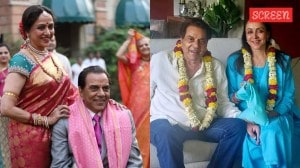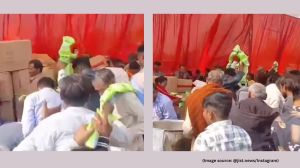Politics of hope and handouts: Why BJP’s Delhi win will have a national echo
Voters have become that much more transactional and pragmatic, aspirational and demanding. Delhi holds out lessons which other states can ill afford to ignore.
 Prime Minister Narendra Modi celebrate the victory of BJP in Delhi elections, at party headquarter in New Delhi on Saturday. (Express Photo: Praveen Khanna)
Prime Minister Narendra Modi celebrate the victory of BJP in Delhi elections, at party headquarter in New Delhi on Saturday. (Express Photo: Praveen Khanna) Delhi is a city-state with limited powers for whoever runs its state government but the verdict on Saturday has the potential to influence national politics more than what Haryana and Maharashtra state polls did last year giving a fillip to the BJP after its unexpected setback in the 2024 Lok Sabha elections.
Haryana and Maharashtra both showed the BJP’s remarkable ability to bounce back – indeed, this has kept its allies on the party’s right side and now there is a buzz that a group from the Shiv Sena (UBT) may soon join the NDA. But Delhi’s ripple effect travels beyond the BJP getting control of one more state.
The party has wrested Delhi after 27 long years of sustained political effort – first against Sheila Dikshit when she was in power for 15 years between 1998-2013, then from Arvind Kejriwal who defeated her in 2013 and swept Delhi in 2015 and 2020, even as Narendra Modi managed to win 7/7 seats in the Lok Sabha polls in 2019 and 2024 general elections.
People wanted Modi for India and Kejriwal for Delhi. This has now changed.
Delhi signals that despite the setback Modi suffered in 2024, his popularity remains intact. There was no other leader the BJP relied on in Delhi as it did on Modi, in what was a virtual referendum on AAP supremo Arvind Kejriwal. Delhi is also a message to the international community — the representatives of world capitals, international media and the multiple agencies which have a presence here —that they will have to deal with a stronger rather than a weaker PM.
This comes when Trumpism poses new challenges to many countries, including India, with trade wars in the offing and images of illegal migrants being deported, shackled and chained.
The two-thirds majority that the BJP has notched up in Delhi — up from eight to 48 — with its vote share up by an impressive around 7 percentage points and the Aam Aadmi Party (AAP) losing 10 percentage points in its vote share shows a ground-level mood for change. Clearly, the party has the support of virtually all sections — and not just the middle-class which was disenchanted with the AAP, and turned towards the BJP.
This, too, is bound to have a ripple effect for Delhi is not just a cosmopolitan hub but also a city of migrants: Punjabis who settled here after Partition and formed the mainstay of the BJP in the early years, Purvanchalis (around 30% today) who have come from UP, Bihar, Jharkhand, or communities like the Valmikis amongst the Dalits, or the Jats, or most importantly, the women who had solidly stood by AAP in the last two elections but now seem to have moved.
Delhi could be a trendsetter indicating that what matters to voters today, especially in cities, may not be just “freebies”, important as they are for the poorer sections. As to the middle class, so also to the jhuggi jhopdi dwellers, other issues are getting greater traction: the right to breathe unpolluted air or the right to drink clean water, not to have to spend hours navigating traffic snarls or travel over potholed roads day after day, or be surrounded by mounds of uncleared garbage and overflowing drains.
The verdict points to other shifts, too. Surely, Kejriwal’s party had initiated reforms in schools and healthcare but the voters were asking for more than just the daily “tu tu main main” between the L-G and the state. Many appear to have voted for BJP hoping that with the resources it is endowed with, and with power at its command at the Centre, it would be better placed to do this than Kejriwal’s AAP.
The BJP’s narrative after its Lok Sabha losses helped it to course-correct in Haryana and Maharashtra. In Delhi, the middle class seems to have bought the argument that “freebies” were doled to the poor at their expense. Many were convinced that the “double engine” sarkar would be beneficial to them. Besides the organisational heft of the BJP, what also helped the party was the way the RSS came out in its support — as it had done in Haryana and Maharashtra.
Those associated with the Sangh talked about 50,000 “drawing room” meetings that RSS functionaries had with small groups of people to mobilise their support. The normal sympathy that might have come Kejriwal’s way for the way his government was hobbled, with agencies putting him and his colleagues in jail for months before the elections, was missing.
The voters have become that much more transactional and pragmatic, aspirational and demanding. Even as caste and community have not disappeared as voting imperatives in different parts of India, Delhi holds out lessons which other states can ill afford to ignore.
The Delhi outcome is bad news for the entire Opposition, for it gives new heart and new impetus to the BJP. It has shown up the fault lines in the INDIA bloc, of which the AAP and the Congress are a part. “Aur lado”, J&K CM Omar Abdullah taunted both the parties.
Most regional parties in INDIA chose to support Kejriwal — and not the Congress — in Delhi, as the two parties fought separately. It is possible that both the AAP and the Congress, which has not moved beyond the princely figure of “0” seats it had notched up in the last two elections, might have fared better had they fought together. Clearly, Opposition parties have to refashion the INDIA alliance if they want to remain relevant. The Congress, whose vote share rose about 2 percentage points to 6.34%, lost deposits in at least 60 seats but polled more votes than the AAP’s margin of defeat in 13 constituencies.
The AAP’s defeat poses existential challenges for a political startup which has so far had a dream run. What will be its impact on the AAP government in Punjab? Or on the cases against Kejriwal and his colleagues in the liquor scam? Will an attempt now be made to delist the AAP as a politicalentity as the ED has suggested?
AAP leaders will now be called to draw on all the reserves at their command to remain afloat, work the street to win back the confidence of the aam aadmi – and fight another day.
(Neerja Chowdhury, Contributing Editor, The Indian Express, has covered the last 11 Lok Sabha elections. She is the author of How Prime Ministers Decide)



- 01
- 02
- 03
- 04
- 05




























